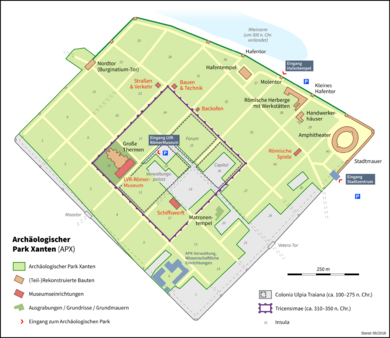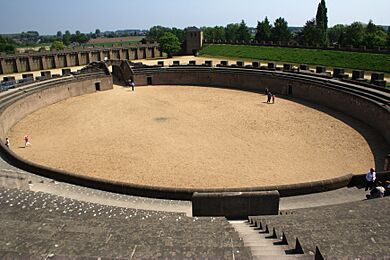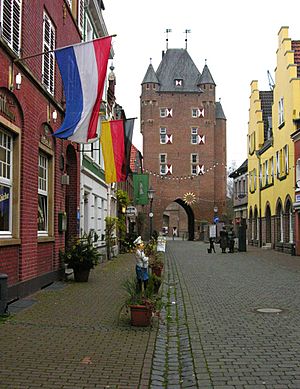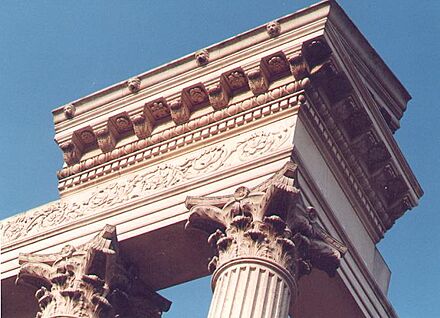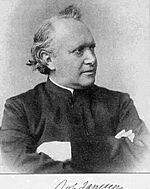Xanten facts for kids
Quick facts for kids
Xanten
|
||
|---|---|---|
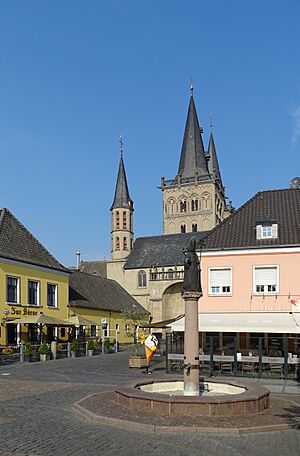 |
||
|
||
| Country | Germany | |
| State | North Rhine-Westphalia | |
| Admin. region | Düsseldorf | |
| District | Wesel | |
| Elevation | 50 m (160 ft) | |
| Population
(2022-12-31)
|
||
| • Total | 21,582 | |
| Time zone | CET/CEST (UTC+1/+2) | |
| Postal codes |
46509
|
|
| Dialling codes | 02801 and 02804 (Marienbaum) | |
| Vehicle registration | WES | |
| Website | www.xanten.de | |
Xanten is a town in the German state of North Rhine-Westphalia. It is located in the Wesel district.
Xanten is famous for its Archaeological Park. This is one of the biggest open-air museums in the world. It was built where the ancient Roman city Colonia Ulpia Traiana once stood.
Other cool places to visit include the old medieval town center. Here you can find the Xanten Cathedral, many museums, and big man-made lakes. These lakes are great for different water sports. About one million tourists visit Xanten every year. It is also the only city in Germany that starts with the letter "X"!
Contents
Exploring Xanten's Location
Xanten is the only German town whose name starts with 'X'. It has three main areas: Hochbruch, Niederbruch, and the town center. Other smaller areas that are part of Xanten include Birten, Lüttingen, Marienbaum, Vynen, Obermörmter, Wardt, Mörmter, Willich, Beek, and Ursel. Part of a nature reserve called Bislicher Insel is also in the town.
The town is next to the Lower Rhine river. To the north, it borders Rees. To the east, it's next to Wesel. To the south, you'll find Alpen and Sonsbeck. To the west, it borders Uedem and Kalkar.
If you want to fly there, the closest international airport is Weeze Airport. It's about 25 kilometers away. A bigger airport, Düsseldorf Airport, is about 60 kilometers away. Xanten also has a train station that connects to Duisburg.
A Journey Through Xanten's Past

Ancient Roman Times
People first settled in this area around 2000 BC. Around 15 BC, the Romans built a military camp called Vetera. It was on a hill near where Birten is today. This camp was a base for Roman armies. It housed 8,000 to 10,000 soldiers. It was destroyed in 70 AD during a rebellion.
After Vetera was destroyed, a second camp, Castra Vetera II, was built. A settlement grew nearby, home to 10,000 to 15,000 people. In 110 AD, the Roman emperor Traianus made this settlement a colonia. This meant it had special rights. He renamed it Colonia Ulpia Traiana. This new city had walls and buildings like an amphitheater. It became a very important trading center.
Around 275 AD, Germanic tribes attacked and almost destroyed the colonia. In 310 AD, a new town called Tricensimae was built in the same area. It was smaller and easier to defend. By the early 5th century, attacks increased, and Tricensimae was finally abandoned.
Around 300 AD, a person named Viktor of Xanten is said to have been killed for his beliefs. He is honored as a saint. His remains are kept in the Xanten Cathedral.
The Middle Ages
In the 5th century, the Franks started living in the Xanten area. They didn't build with stone like the Romans, so we mostly find their graves from this time.
An old legend says that the mythical hero Siegfried of Xanten was born here.
In the late 700s, a church was built on an old Roman cemetery. It was called Sanctos (meaning "place of saints"). This name came from the believed grave of Saint Viktor. This is how Xanten got its name. A town center grew around a nearby religious community.
In 939, King Otto I won a battle near Xanten. This helped him keep control of the Rhineland.
By 1122, Xanten was an important trading town. On July 15, 1228, Xanten officially became a town. This right was given by the Archbishop of Cologne.
During the First Crusade in 1096, there were sad events involving the Jewish community in Xanten.
In 1263, construction began on the beautiful Gothic St. Victor cathedral. It took 281 years to build and was finished in 1544. By the late 1300s, Xanten was surrounded by a town wall.
In 1392, the northern part of Xanten became part of the Duchy of Cleves. The southern part stayed with the Archbishopric of Cologne. This caused a conflict. In 1444, all of Xanten became part of the Duchy of Cleves.
Early Modern Times
After becoming part of Cleves, Xanten faced hard times. Wars and bad harvests caused the number of people living there to drop. The Rhine river, which was important for trade, also changed its path. This made Xanten's economy worse.
However, the area of Marienbaum became a popular place for religious journeys between 1430 and 1441. A monastery was built there in 1460.
In the 1600s, Xanten became part of Margraviate of Brandenburg. A treaty in 1614 said that both Protestant and Catholic religions had equal rights. A Protestant church was built in Xanten.
19th and Early 20th Century
In 1802, the Viktor-convent was closed by Napoléon Bonaparte. Its libraries were combined. Xanten's economy continued to struggle. Some old town gates and walls were taken down. However, in 1843, a town official stopped the removal of the Klever Tor gate and a mill.
At the same time, people became interested in the ruins of the Roman city Colonia Ulpia Traiana. These ruins had been used as a quarry for a long time. Between 1819 and 1844, archaeologists started digging there.
Xanten was part of Prussia from 1822 to 1945. In 1927, the Catholic Church celebrated its 1,600th anniversary. In 1937, Pope Pius XI gave the St. Viktor cathedral the special title of a basilica minor.
World War II and After
During World War II, an ammunition factory was built near Xanten. People from Xanten and later forced laborers worked there. The town was heavily bombed in February 1945. The cathedral was also badly damaged. On March 8, Canadian troops took Xanten. The town was about 85% destroyed. The people were moved away while the Allies crossed the Rhine river. When the crossing happened on March 24, the war was over for Xanten.
After the war, the town and cathedral were rebuilt. This work lasted until 1966. Many people who had to leave their homes in East Prussia moved to Xanten. This made the population grow a lot. In 1969, several nearby areas joined Xanten, making the town much larger.
In 1975, the Archäologischer Park Xanten (Xanten Archaeological Park) was opened. It shows a partial reconstruction of the Roman city. It became a popular place for visitors.
In 1988, Xanten was recognized as a "state-recognized leisure town." This was the first town in the Düsseldorf region to get this title. Between 1990 and 2004, Xanten's population grew from about 16,930 to 22,000 people.
Fun Things to Do in Xanten
The Archäologischer Park Xanten is built on the site of the old Roman town. It is one of the most visited parks in Germany. In 2012, the park was made even bigger.
Many old buildings in the town center have been fixed up. Near the areas of Wardt and Vynen, there are two lakes, Xantener Südsee and Xantener Nordsee. They are connected by a channel. The Freizeitzentrum Xanten (Xanten Leisure Center) was built here in 1982. Today, it's a favorite spot for people who love to sail.
Xanten's Culture and Events
Xanten hosts some big events. The Xantener Sommerfestspiele was a classical music festival that ran for two weeks every summer. There's also the yearly KleinMontMartre, where artists from all over the world show their art. Xanten also holds an annual German sandcastle-building championship!
Learning in Xanten
Xanten has several schools. These include a grammar school called Stiftsgymnasium Xanten. There is also a private school for girls, the Marienschule.
How Xanten is Governed
Town Council Seats (2020 Elections)
| Party | Number of seats | |
|---|---|---|
| CDU | 16 | |
| SPD | 7 | |
| Local initiative | 5 | |
| Alliance '90/The Greens | 5 | |
| FDP | 1 | |
| The Left | 1 | |
| BBX | 1 | |
Xanten's Sister Cities
Xanten has friendly connections with other towns around the world. These are called sister cities:
Famous People from Xanten
- Georg Bleibtreu (1828–1892), a painter who focused on battle scenes.
- Gottfried Hagen (1230–1299), a writer for the city of Cologne.
- Dorothe Ingenfeld (born 1974), an opera singer.
- Johannes Janssen (1829–1891), a historian.
- Reinhart Maurer (born 1935), a philosopher.
- Norbert of Xanten (c. 1075–1134), a Catholic bishop and founder of a religious order.
- Diederich Franz Leonhard von Schlechtendal (1794–1866), a botanist who studied plants.
See also
In Spanish: Xanten para niños



